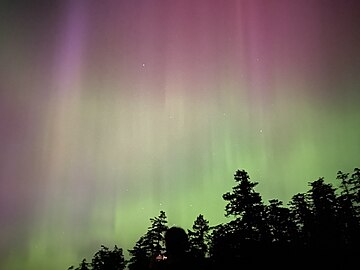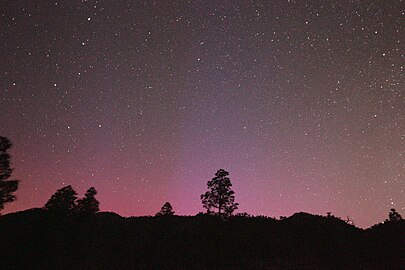May 2024 solar storms
This article is about a current solar storm where information can change quickly or be unreliable. The latest page updates may not reflect the most up-to-date information. Please refer to your local weather service or media outlets for the latest weather information pertaining to a specific location. |
| File:May 10 2024 Aurorae from Arkansas.jpg | |
| Date | May 2024 |
|---|---|
| Type | Coronal mass ejection |
| Part of Solar cycle 25 | |
The solar storms of May 2024 are a series of powerful solar storms with intense to extreme solar flare and geomagnetic storm components that have been ongoing since 10 May 2024. These storms were seen as far south as Florida, during solar cycle 25.[1][2] The storm produced aurorae at far lower latitudes than usual in both northern and southern hemispheres.[3]
Solar flares and coronal mass ejections
On 8 May 2024, a solar active region, which had been assigned the NOAA region number 3664, produced multiple near X-class and X-class solar flares and launched several coronal mass ejections (CME) in Earth's direction. The following day, the active region produced two additional X-class flares (X2.25 and X1.12) associated with two full-halo CMEs. The region produced X3.98 flare the next day and on 11 May it produced X5.89 flare with another asymmetrical full-halo CME.[4][5][6][7][8] The region also caused a S1 solar radiation storm with spikes to S2.[citation needed]
The eruption of an additional X5.4-class solar flare was reported 11 May 2024 at 01:23 UTC.[9]
Geomagnetic storm

Three CMEs from 8 May reached Earth on 10 May 2024, causing severe to extreme geomagnetic storm with bright and very long-lasting aurorae. Aurorae could be seen from Europe immediately after sunset even in Croatia.[10] In North America aurorae were seen as far south as Florida[11] and Zacatecas.[12] In the southern hemisphere the aurora was seen in New Zealand,[13] Australia,[14] Chile and Argentina.[15] Due to the interplanetary magnetic field reaching a magnitude of 73 nT with the component along Earth's magnetic axis oriented strongly south, reaching −50 nT, as well as due to moderately high solar wind density and speed reaching 750–800 km/s,[when?] the event was classified as G5-class geomagnetic storm, making it the most intense storm since the 2003 Halloween solar storms.[8] Several other CMEs are expected to reach on 11 and 12 May.[16]
Comparison to other solar storms
The disturbance storm time index is a measure in the context of space weather. A negative Dst value means that Earth's magnetic field is weakened. This is particularly the case during solar storms. The May 1921 geomagnetic storm had estimates of intensity of Dst = −907±132 nT, whilst estimates for the Carrington Event superstorm of 1859 are between −800 nT and −1750 nT.[17]
Currently, the highest negative measurement for the May 2024 solar storms is −412 nT.[18]
Gallery
![]() Media related to May 2024 solar storms at Wikimedia Commons
Media related to May 2024 solar storms at Wikimedia Commons
Aurorae
-
Aurora as seen from Osage Beach, Missouri, U.S. (38°N)
-
Aurora as seen from Pawleys Island, South Carolina, U.S. (33°N)
-
Aurora as seen from East Sussex, UK (51°N)
-
Aurora as seen from Okeford Hill, Dorset, UK (50°N)
-
Aurora as seen from Bay View, Washington, U.S. (48°N)
-
Aurora as seen from Kraków, Poland (50°N)
-
Aurora as seen from the Gran Canaria, Northwest Africa part of Spain (28°N)
See also
References
- ^ Miller, Katrina; Jones, Judson (10 May 2024). "Solar Storm Intensifies, Filling Skies With Northern Lights". The New York Times. Archived from the original on 11 May 2024. Retrieved 11 May 2024.
- ^ Fritz, Angela; Hammond, Elise; Lau, Chris (10 May 2024). "Live updates: The latest on the massive solar storm". CNN. Archived from the original on 11 May 2024. Retrieved 11 May 2024.
- ^ Ralls, Eric (10 May 2024). "Auroras expected all weekend across the U.S. as massive solar storm hits Earth". Earth.com. Archived from the original on 11 May 2024. Retrieved 11 May 2024.
- ^ "Sunspot region AR13664". SpaceWeatherLive. Retrieved 11 May 2024.
- ^ "Sunspot region 3664, major flares and CMEs!". SpaceWeatherLive. 8 May 2024. Retrieved 11 May 2024.
- ^ "Severe G4 geomagnetic storm watch". SpaceWeatherLive. 9 May 2024. Retrieved 11 May 2024.
- ^ "CME impact imminent, Two more earth-directed CMEs". SpaceWeatherLive. 10 May 2024. Retrieved 11 May 2024.
- ^ a b "Strongest geomagnetic storm since 2003, X5.8 solar flare". SpaceWeatherLive. 11 May 2024. Retrieved 11 May 2024.
- ^ "Yet Another X-class Flare!". Space Weather Prediction Center. National Oceanic and Atmospheric Administration. 11 May 2024. Archived from the original on 11 May 2024. Retrieved 11 May 2024.
- ^ Adams, Lead Forecaster Josh (10 May 2024). "Aurora Borealis Forecast for Friday Night as Large Geomagnetic Storm Rages, Causing Northern Lights to Shine". PA Weather Action. Retrieved 11 May 2024.
- ^ "'Unbelievable!': Northern Lights seen in South Florida from 'severe' solar storm". NBC 6 South Florida. 11 May 2024. Retrieved 11 May 2024.
- ^ Torres Vargas, César Eduardo (11 May 2024). "Estas son las mejores fotos de las auroras boreales en el norte de México". Infobae. Retrieved 11 May 2024.
- ^ "Incredible photos: Stunning aurora dazzles NZ skies". NZ Herald. 11 May 2024. Retrieved 11 May 2024.
- ^ Shepherd, Tory; Paul, Kari (11 May 2024). "Spectacular southern lights seen across Australia after 'extreme' solar storm". The Guardian. ISSN 0261-3077. Retrieved 11 May 2024.
- ^ "Aurora Austral impresiona en los cielos del sur de Chile". MSN. 11 May 2024. Retrieved 11 May 2024.
- ^ "SWPC Issues Its First G4 Watch Since 2005". Space Weather Prediction Center. 9 May 2024. Retrieved 11 May 2024.
- ^ "Near Miss: The Solar Superstorm of July 2012 – NASA Science". science.nasa.gov. Archived from the original on 11 May 2024. Retrieved 11 May 2024.
- ^ "Real-time Dst Index". World Data Center for Geomagnetism, Kyoto. Archived from the original on 10 May 2024. Retrieved 11 May 2024.







